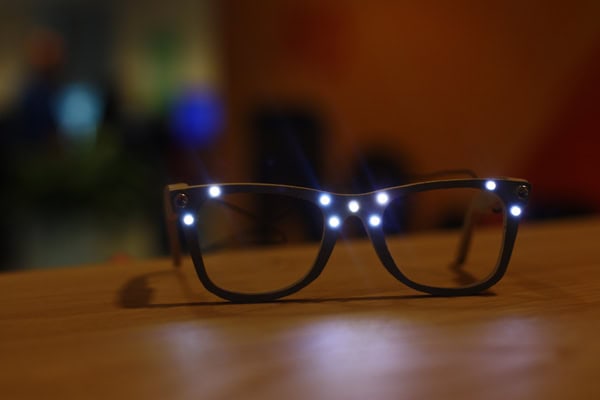
[Image above] Credit: AVG Netherlands BV
One of the most visible technologies as of late: Invisibility.
From invisibility cloaks made from optical lenses to glass-nanosphere-coated clothing that makes you invisible from the flashbulbs of photographers, one thing is clear—no one wants to be seen.
I get it. I share a lot of who I am and what I do with my pretty private social networks—but my social networks share even more with and without my knowledge. (Ever Googled yourself? It’s more than a little creepy that a search for my own name shows not only photos from my CTT posts but the images of my friends and contacts. That means that even if I lock down my own social sharing, my photos could be fodder for Internet searches simply by connecting with an old college friend.)
For those who want to give cameras and facial recognition technology the slip, anti-virus software company AVG has developed a pair of invisibility glasses designed to protect your visual identity online.

Credit: AVG Netherlands BV
Showcased at Pepcom Barcelona prior to last week’s Mobile World Congress, the glasses are the latest in privacy wearables and prevent technologies like Google’s StreetView and Facebook’s DeepFace (a.k.a., that annoying box that attempts to tag your friends when you upload a new pic) from recognizing your face.
They feature two different methods for foiling facial recognition—infrared lighting and retro-reflective materials. According to AVG, this is the first time anyone has attempted combining the two in a single wearable. (Pioneering spirit for the win!)

Credit: AVG Netherlands BV
The infrared lighting was developed by Isao Echizen, professor at the Tokyo National Institute of Informatics. Echizen inserted infrared LEDs, which humans can’t see but cameras can detect, around the eyes and nose area of the invisibility glasses. When switched on, the LEDs “break” facial recognition—well, most of the time. In testing, some cellphone cameras, including almost all iPhones and some Android phones, had infrared filters strong enough to cut off wavelengths beyond the visible spectrum (i.e., Mark Zuckerberg’s photo-mining technology would still be able to make out who you are).
Similar to Betabrand’s Flashback clothing line, the second method involved applying retro-reflective materials to the glasses, a move that came with its own set of drawbacks. I’ll let the experts at AVG explain exactly how and why.
While most surfaces reflect light by diffusing or scattering it in all directions, retro-reflective materials are specially designed to reflect light back at the same angle as it arrived.
If caught in flash photography, retro-reflective materials will send most of the light back to the sensor. This will result in an image that will put the Dynamic Range of the camera sensor to test.
A noticeable drawback of this approach is that it only works with flash photography as otherwise, not enough light will be sent back to distort the camera sensor. Secondly, a camera with higher dynamic range can be used to minimize the darkening of the subject.
Conclusion? Neither method is failproof, but since the glasses are more a matter of proof-of-concept stage, we think it’s a step in the right (and more private) direction.
AVG reports that further testing is needed to develop a “universal technique that will work for all cameras, under all lighting conditions” and that they are also working on an approach that uses projected infrared patterns and makeup.
If you’re hungry for more, you can get all the details and data from their experimentation here.
For some related reading, check out this recent post on wink-controlled eyeglasses and telescopic contact lenses.
Author
Jessica McMathis
CTT Categories
- Electronics
- Glass
- Material Innovations
- Weekly Column: “Other materials”







